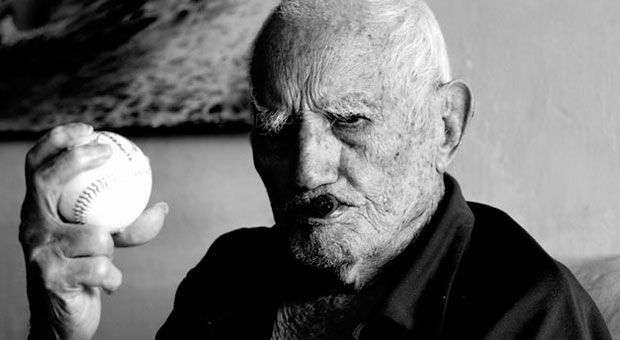Two days before his 103 birthday, the legendary Conrado Eugenio Marrero Ramos died and left vacant the position as the oldest Major League player in the world.
“He was breathing, but his eyes were blank ,” confessed his grandson Rogelio Marrero to international media outlets minutes after the death of El Guajiro de Laberinto , which set guidelines in the first half of the twentieth century with an exquisite style of pitching, based on the control and the variety of pitches.
These details made the “Premier” a real conundrum for opponents, dying before the steep curves that will make dizzy the thousands of fans in the stands stationed just to see an artist of the mound.
Unfortunately, I never had my hands on even a fragment of those memorable works, no one saved a gray and rainy video anthology of these duels, when he pitched for the Almendares , the Washington Senators or the Cuban national team.
I learnt of Marrero, his exploits, his arm of iron, his longevity in diamonds, from the endless references of my grandfather, who in my first baseball talks used to tell me how he got just three steps away from shaking his hand when he wore the Blue Scorpions jersey.
My grandfather, an eternal feature at the Gran Stadium del Cerro, watched Marrero’s dissertations Sunday after Sunday, in famous duels and dances of zeros, because he made of shutouts his everyday’s work.
“He was not tall, nor impressed. Beside hitters at that time he seemed a skinny kid. But when he climbed on the mound to pitch Troy burned, a huge curve, with a thread no longer abundant, everything broke right, and combined with a ‘little fastball’ contrasting with the rest of the repertoire, ” my grandfather tells me, who has very clear in his memory those afternoons of professional baseball in the Cerro stadium.
In his time, Marrero was just a supernatural phenomenon. They say he played at third base and shortstop, until one day the pitcher of his team was beaten and he came to relieve. From that moment, he made the mound a sanctuary, where he starred in countless epic battles; the most remembered, perhaps, that with the Venezuelan Daniel “Chino” Canónico in the World Championship in 1941.
Later, he enlarged his figure in the Cuban League Amateur and Professional League, with statistics from another galaxy in wins, complete games, innings pitched and shutouts, very eloquent parameters of his durability and strength as a pitcher.
But the ultimate expression of this detail is in the 50s, when he managed to succeed with almost 40 years in the most demanding environment of the planet, during a time when mythical Willie Mays, Joe DiMaggio, Yogi Berra, Mickey Mantle or Ted Williams strolled by the haughty U.S.MLB.
Precisely, Williams portrayed him with a memorable statement: “Marrero is the exception to the rule. It is not very common for a pitcher to jump from one league of lower classification as the Florida International League to the Majors and triumph out of the blue. And it is uncommon to expect much from a pitcher who is only five feet seven inches tall and weighs no more than 158 pounds. The tendency is to ignore pitchers that are not bulky and cannot throw very hard. Marrero defies all the rules. ”
Despite not having awesome numbers (39 wins, 40 losses, 3.96 ERA and 297 strikeouts) with the Washington Senators, “Connie”, as he was known from his arrival in the major leagues, he was also described as fabulous in a baseball where wild beasts abounded; some even accompanied him on the All-Star Game on July 10, 1951.
His death is not only a blow to the history of Cuban baseball, which lost one of its most prominent legends right at the worst time since the dawn of the sport in the island










